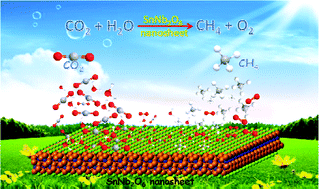Photocatalytic reduction of CO2 with H2O to CH4 over ultrathin SnNb2O6 2D nanosheets under visible light irradiation†
Abstract
Monolayer SnNb2O6 two-dimensional (2D) nanosheets with high crystallinity are prepared by an one-pot and eco-friendly hydrothermal method without any organic additives. For the first time, these SnNb2O6 nanosheets are applied to the photocatalytic reduction of CO2 with H2O to CH4 in the absence of co-catalysts and sacrificial agents under visible light irradiation. The structural features, morphology, photoabsorption performance, and photoelectric response have been investigated in detail. Results show the as-prepared SnNb2O6 samples with typical 2D nanosheets in the thickness of about 1 nm. Owing to the unique features of the nanosheets, the surface area, photoelectrical properties and the surface basicity of SnNb2O6 are greatly improved compared with the counterpart prepared by traditional solid state reaction. Furthermore, the adsorption capacity of CO2 on SnNb2O6 nanosheets is much higher than that of layered SnNb2O6. Thus, the photocatalytic activity of SnNb2O6 nanosheets for the reduction of CO2 is about 45 and 4 times higher than those of the references (layered SnNb2O6 and common N-doped TiO2), respectively. To understand the interactions between the CO2 molecule and the surface of the photocatalyst, and the reactive species in the reduction process, the intermediates have also been detected by in situ FTIR with and without visible light irradiation. Finally, a possible mechanism for the photocatalytic reduction of CO2 with H2O to CH4 on SnNb2O6 nanosheets is proposed. We believe this work will provide new opportunities for expanding the family of visible-light driven photocatalysts for the reduction of CO2.


 Please wait while we load your content...
Please wait while we load your content...